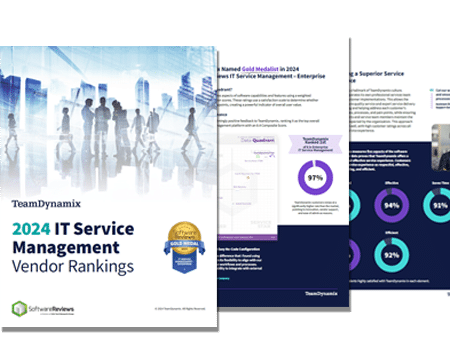
Companies Say They Need Automation, Easy-to-Manage ITSM
A study from Information Week and TeamDynamix shows companies are looking to invest in IT Service Management (ITSM) software that is simple to administer and

The Info-Tech ranking report offers a unique view of the market based entirely on in-depth customer interviews. Download the Info-Tech ITSM Quadrant and Customer Viewpoint report today.

We’ll show you some of our best situations and show you exactly how to execute them to get immediate results. The best part is, iPaaS tools often feature easy-to-use click and drag functionality, meaning you don’t need a dedicated employee building integrations and workflows.

System Integrators, Value Added Resellers, Technology Providers, and Buying Consortiums can benefit from a partnership with TeamDynamix.

The Info-Tech ranking report offers a unique view of the market based entirely on in-depth customer interviews. Download the Info-Tech ITSM Quadrant and Customer Viewpoint report to gain a better understanding of key vendor strengths and emerging market requirements.
Proper service management is critical for any organization that relies on technology to operate. And when you have service management issues it can lead to disruptions in business operations and frustrated customers.
In this blog post, we’ll discuss some of the most common issues in IT Service Management (ITSM) and how to solve them. By identifying and addressing these issues, you can improve your organization’s ITSM capabilities and keep your business running smoothly.
IT Service Management, or ITSM as it’s often referred to, is the process that organizes, monitors and helps deliver IT services to customers. It is a broad set of best practices designed to help organizations define the scope of their IT services and develop strategies for IT service delivery. ITSM uses technologies like incident management, asset management, process automation and self-service tools to enable customers to get what they need quickly and efficiently.
The goal of ITSM is to enable organizations to increase customer satisfaction by providing effective and efficient IT services in order for them to reach their desired outcomes sooner.
Because there are a lot of moving parts when it comes to IT Service Management, everything that goes into managing IT services can be complex. Due to this complexity, there are often mistakes that can be made and common issues that arise.
Security is one of the main issues IT teams have to deal with on a regular basis. Unauthorized access or malicious actors attempting to gain access to sensitive data has become a growing concern.
Managing various systems concurrently is another issue as it requires more resources and man-hours and maintaining compatibility over multiple devices can be complicated.
Additionally, providing round-the-clock server availability for vast amounts of users is yet another challenge IT teams face regularly. The good news is that with proper training and careful planning, these common issues can effectively be remedied.
While IT Service Management is essential for any organization to run smoothly, it can be difficult to address the issues that can arise through service management. Fortunately, there are several best practices you can adopt to help manage your IT services more effectively.
To start, automated processes and proactive monitoring should be implemented to improve your service availability and response times. Additionally, providing quick and easy access to self-service resources helps users solve many simple IT issues on their own – meaning they never have to put in a ticket or call your IT help desk.
Documenting key resolutions in a central knowledge base also helps fast-track future investigations when similar problems occur.
With these steps in place, ITSM issues can be efficiently resolved so your teams can continue running like a well-oiled machine.
Taking preventive action can be an effective way of avoiding future issues. Implementing changes to policies and procedures can help ensure that these issues don’t arise in the first place.
Plans need to be realistic, tailored to the individual business or situation and have defined goals so progress can be monitored. Thinking forward is essential – businesses should always try to anticipate potential problems before they become serious issues. It helps if they assess the effectiveness of existing processes and make changes as needed.
Keeping on top of current trends and best practices can be a good starting point when looking at what needs updating – keep up to date on ITIL best practices and Knowledge-Centered Service (KCS). If a comprehensive review of needs is done carefully, making changes to prevent future issues becomes much simpler.
IT service management is a broad and complex field, but by understanding its scope, common issues, and root causes, you can take steps to solve problems and prevent future issues. Implementing changes based on your findings is essential to ensuring that your IT services run smoothly. By following these steps, you can ensure that your IT Service Management is up to par.

A study from Information Week and TeamDynamix shows companies are looking to invest in IT Service Management (ITSM) software that is simple to administer and

When it comes to improving IT Service Management (ITSM) maturity, many organizations turn to ITIL – a framework that guides users through a process-based approach

Enterprise Service Management (ESM) is the practice of extending IT Service Management (ITSM) principles beyond the IT department to other areas of an organization. ESM
TeamDynamix’s award-winning SaaS cloud solution offers IT Service and Project Management together on one platform with enterprise integration and automation.
[email protected]
(877) 752-6196
Contact Us
